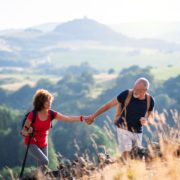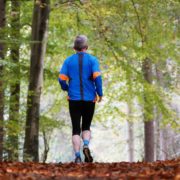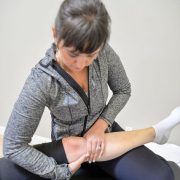How to Prevent Knee Pain When Hiking
Hiking is a popular way to stay active during the summer months – but it can also wreak havoc on your knees.
Personally, I love to hike. My pup (Bodie) and I are currently in the process of conquering the 48 4K footers of the White Mountains – and the very last thing I want is for knee pain to get in the way of that journey.
The good news is that there is quite a bit you can do to prevent knee pain when hiking. So when one of my readers asked this week – “How do I prevent knee pain when hiking?” – I couldn’t wait to answer it.
Here are 4 of my top tips to help you prevent knee pain when hiking.
1. Strengthen your hips and core
Your hips and core provide much needed support for your knee joint to function properly. The large bone in your thigh, called your femur, makes up your knee joint on the bottom, and your hip joint on the top. Your hip joint is connected to your pelvis, which houses major core muscles groups like your glutes.
Let’s say your glutes (part of your core) and hip muscles aren’t as strong as they could be. When you’re trying to climb up a large rock or steep trail, for example, your glutes and hip muscles are supposed to stabilize your pelvis so that your femur can easily extend your hip. When not strong enough, your pelvis will tilt to compensate – which impacts the alignment of your femur – and ultimately the alignment of your knee.
When I hike a 4k footer – I get in approximately 27,000 steps. If your knee is compensating for every one of those steps – it’s eventually going to hurt. If hiking is something you love to do, it’s critical that you strengthen your hips and core.
2. Keep your knees mobile
One of the biggest mistakes I see when it comes to knee problems is a lack of full mobility. Your knee shouldn’t just straighten, it should be able to hyperextend a little bit. When you bend your knee, you should be able to tolerate a full deep squat without any pain. These full end range movements are pretty essential to have when it comes to hiking. Your knee needs to be able to squat, pivot, and tolerate stress on those uneven trails. When you lack full mobility, it impacts your knee’s ability to tolerate these micro-stresses and over time – your knees will ache.
If you’ve got pain or stiffness in your knee in either direction of movement – it’s important to try and push that movement and work through it rather than avoid it – even if your knee seems painful at first. More often than not, the more you move your knee joint, the better it will feel. If that doesn’t happen – then you know it’s time to talk to an expert about it and have them take a closer look at your knee.
3. Work on your balance
Hiking can involve everything from uneven terrain, water crossings, and rock hopping. Good balance is essential for these activities and without it – your knees will suffer.
So how do you work on your balance?
Aside from the obvious (practicing balance exercises), it’s also important to look at a few other things – namely – the mobility of your toes, foot and ankle joints as well as the strength of your arch (plantar fascia). These structures all play a role in how well you’re going to be able to balance. You can do all the balancing exercises in the world, but if you’ve got faulty mobility in your ankle, for example, or a flat, weakened arch – balance is always going to be really difficult for you.
Perform regular stretching of your ankle and calf muscles, Be sure to move those toes – can you lift your big toe up by itself when you’re standing? And use a small ball to regularly massage the arch of your foot to keep it flexible. These small activities can play a huge role in helping you to be able to balance with more ease – especially on the trials.
4. Use Trekking Poles
Even if you implement every single tip I mentioned above, depending on your overall level of fitness, and the condition of your knees prior to when you decided to get into hiking, you could still have some knee pain despite doing “everything right”.
Trekking poles can be a real life saver – or should I say knee-saver.
They help take away some of the stress from your knees and lower legs – especially on really long hikes and technically challenging trails. Plus, if you’re carrying a backpack, trekking poles help to disperse that extra weight away from your knees and into your arms. And added bonus – hiking with poles gives your arms a little extra workout at the same time and keeps your hands and fingers from getting puffy on those extra hot and humid days.
If you love hiking as much as Bodie and I do – then I know the last thing you want is for knee pain to keep you from hiking. I hope these tips help you to ease any knee pain you might currently have as well as prevent future knee pain on the trails.
Do you love to hike but knee pain is currently getting in the way? CLICK HERE to talk to one of our specialists.
They’ll let you know if we can help – and if you’re a good fit for what we do – they’ll get you on our schedule right away.
Dr. Carrie Jose, Physical Therapist and Pilates expert, owns CJ Physical Therapy & Pilates in Portsmouth and writes for Seacoast Media Group. To request a free copy of her Knee Pain Free Report CLICK HERE or to get in touch, email her at [email protected].






